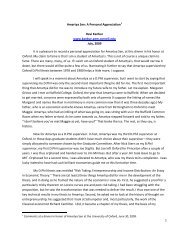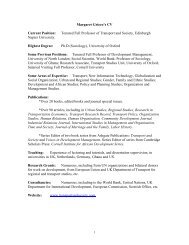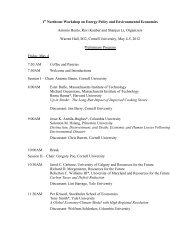Transition from IBRD-IDA Blend to IBRD-only: Issues ... - Ravi Kanbur
Transition from IBRD-IDA Blend to IBRD-only: Issues ... - Ravi Kanbur
Transition from IBRD-IDA Blend to IBRD-only: Issues ... - Ravi Kanbur
You also want an ePaper? Increase the reach of your titles
YUMPU automatically turns print PDFs into web optimized ePapers that Google loves.
<strong>Transition</strong>ing <strong>from</strong> <strong>IDA</strong>-<strong>IBRD</strong> <strong>Blend</strong><br />
<strong>to</strong> <strong>IBRD</strong> Only: <strong>Issues</strong> for Vietnam<br />
Presentation <strong>to</strong> World Bank Vietnam Office, Hanoi<br />
<strong>Ravi</strong> <strong>Kanbur</strong><br />
www.kanbur.dyson.cornell.edu<br />
May 6, 2011
Some Papers<br />
• Andy Sumner, “Global Poverty and the New Bot<strong>to</strong>m Billion”. IDS Working<br />
Paper. IDS: Sussex, UK, 2010<br />
• <strong>Ravi</strong> <strong>Kanbur</strong> and Andy Sumner, “Poor Countries or Poor People? Development<br />
Assistance and the New Geography of Global Poverty,” February, 2011.<br />
• <strong>IDA</strong> Resource Mobilization Department (CFPIR), “A Review of <strong>IDA</strong>’s Long Term<br />
Financial Capacity and Financial Instruments,” February, 2010.<br />
• Todd Moss and Benjamin Leo, “<strong>IDA</strong> at 65: Heading Toward Retirement or a<br />
Fragile Lease on Life?” Center for Global Development, Working Paper 246,<br />
March, 2011.<br />
• <strong>Ravi</strong> <strong>Kanbur</strong>, “The Role of the World Bank in Middle Income Countries,”<br />
September, 2010.<br />
• Independent Evaluation Group. 2007. Development Results in Middle Income<br />
Countries: An Evaluation of the World Bank’s Support. Independent Evaluation<br />
Group, The World Bank.<br />
• <strong>Ravi</strong> <strong>Kanbur</strong>, "IFI's and IPG's: Operational Implications for the World Bank", in<br />
Ariel Buira (edi<strong>to</strong>r), Challenges <strong>to</strong> the World Bank and IMF: Developing Country<br />
Perspectives. Anthem Press, 2003.
Introduction<br />
• Countries like Viet Nam and India will graduate<br />
<strong>from</strong> <strong>IDA</strong> in the blink of an eye. This raises two<br />
categories of questions.<br />
• First, global level questions on per capita income<br />
criterion for graduation in light of the “New<br />
Global Geography of Poverty.”<br />
• Second, specific questions for the newly <strong>IBRD</strong><strong>only</strong><br />
countries on the Bank’s comparative<br />
advantage and how best <strong>to</strong> use the Bank’s<br />
resources.
The New Geography of Global Poverty<br />
• A striking stylized fact (Sumner, 2010).<br />
• Two decades ago, 90% of the world’s poor lived in LICs.<br />
Today, three quarters of the world’s poor live in MICs.<br />
• Not just India (450m) and China (200m). Nigeria,<br />
Indonesia, Pakistan, Philippines <strong>to</strong>gether account for<br />
more than 200m.<br />
• The poor haven’t moved, of course! They have been<br />
reclassified.<br />
• But this reclassification matters, because it affects how<br />
they are seen by the current architecture of<br />
development assistance.
<strong>IDA</strong> in 2025: Who’s Left and What Do<br />
They Get?<br />
• Moss and Leo projections for 2025 (middle of<br />
<strong>IDA</strong> 20 period):<br />
• 31 countries (From Asia: Myanmar, Nepal,<br />
Timor-Leste, Afghanistan<br />
• With one third of the current populatio<br />
• Largely African (From Asia: Myanmar, Nepal,<br />
Timor-Leste, Afghanistan)<br />
• $17 per capita, double the current allocation
Arguments for Changing the Rules: The<br />
New Geography of Global Poverty<br />
• A number of arguments for continued concessional<br />
assistance <strong>to</strong> MICs (global public goods and knowledge<br />
spillovers, see <strong>Kanbur</strong>, 2003).<br />
• The really BIG argument in favor of changing the rules<br />
of the current development assistance architecture is<br />
that countries that are have graduated and are due <strong>to</strong><br />
graduate <strong>from</strong> LIC <strong>to</strong> MIC status have large numbers of<br />
poor.<br />
• A global perspective that targets poor people rather<br />
than poor countries might come up with a different<br />
graduation policy.
Arguments for Changing the Rules:<br />
Possible Operationalization<br />
• Poverty within countries is often clustered within<br />
states/provinces.<br />
• Thus a rule which stays with a “per capita income<br />
cu<strong>to</strong>ff” frame but combines continued support<br />
beyond MIC status with targeting <strong>to</strong> the poor<br />
could be the following:<br />
• The per capita cu<strong>to</strong>ff applies <strong>to</strong> states/provinces.<br />
If a state/province within a country is below the<br />
standard cu<strong>to</strong>ff, the country is eligible provided<br />
the resources are used for the development of<br />
the state/province in question.
Arguments for Changing the Rules: A<br />
Possible Operationalization<br />
• More generally, projects and operations that<br />
can be shown <strong>to</strong> be targeted <strong>to</strong> the poor can<br />
continue <strong>to</strong> have access <strong>to</strong> concessional<br />
finance.<br />
• This would apply beyond the LIC/MIC cu<strong>to</strong>ff<br />
(but perhaps s<strong>to</strong>p at, say, three or five times<br />
the cu<strong>to</strong>ff).
Arguments for Changing the Rules:<br />
Some Counter-Arguments<br />
• The above approach, of giving weight <strong>to</strong> the<br />
absolute numbers of the poor would change<br />
dramatically the future of development<br />
assistance. For <strong>IDA</strong>, Countries like Indonesia<br />
would become eligible again. Countries like India<br />
and Viet Nam would remain eligible for much<br />
longer. Countries like Ethiopia would get less than<br />
they would have if India and Viet Nam do not<br />
graduate (and donor flows remain at current<br />
levels).<br />
• But there are several counter arguments.
Arguments for Changing the Rules:<br />
Some Counter-Arguments<br />
• The poor in LICs are poorer on average than<br />
those in MICs.<br />
– BUT this is an empirical question. There is some<br />
evidence that Human Development in the poorest<br />
parts of MICs is abysmally low. If necessary this<br />
can be taken in<strong>to</strong> account.
Arguments for Changing the Rules:<br />
Some Counter-Arguments<br />
• The fact that poverty persists in MICs <strong>to</strong> such<br />
an extent surely reflects lack of political will—<br />
almost by definition it cannot be lack of<br />
resources.<br />
– BUT, there may be lack of political will also in LICs.<br />
This needs <strong>to</strong> be assessed on a case by case basis,<br />
and resources targeted appropriately. The<br />
“Poverty Reduction Performance” indica<strong>to</strong>rs for<br />
MICs, and a focus on poor regions, could address<br />
targeting of resources.
Arguments for Changing the Rules:<br />
Some Counter-Arguments<br />
• Some MICs have their own aid programs. How<br />
can a country justify receiving concessional aid<br />
while at the same time giving aid?<br />
– BUT many blend countries have, and have had, aid<br />
programs. This has not, so far, led <strong>to</strong> an aid cut-off.<br />
Funds are fungible in general, but if engagement<br />
with <strong>IDA</strong> for example, can lead <strong>to</strong> a better<br />
targeting of national resources <strong>to</strong>wards the poor,<br />
this is an outcome for which it is worth extending<br />
aid eligibility.
Arguments for Changing the Rules:<br />
Some Counter-Arguments<br />
• While concessional funds are valuable <strong>to</strong> a<br />
MIC, accessing them may not comport with its<br />
self image (or the self image of its political and<br />
policy making elite) as a player on the world<br />
stage, perhaps a member of G20, ready <strong>to</strong><br />
intensify its own aid programs <strong>to</strong> even poorer<br />
countries for humanitarian or political ends.<br />
– BUT…..There is no but here. This is a fundamental<br />
tension each <strong>IDA</strong> recipient country must resolve<br />
for itself.
<strong>IDA</strong> Graduation Policy: What is the<br />
Most Likely Outcome?<br />
• Change unlikely in the very near future because of<br />
counter arguments, vested interests, and disparate<br />
interests of forthcoming graduands.<br />
• However, As the big countries graduate and reflows<br />
grow, and concessional aid is left with an ever smaller<br />
group of countries <strong>to</strong> engage with while poverty<br />
problems persist in MICs and need attention, global<br />
and regional concern may bring about a profound<br />
reflection on the rules and policies according <strong>to</strong> which<br />
it operates.<br />
• A number of us are pushing for such a major rethink,<br />
and we may succeed eventually. In the mean time….
WB and MICs (1)<br />
• I want <strong>to</strong> start <strong>from</strong> the fact that <strong>IBRD</strong> resources are limited<br />
for a country.<br />
• Gross flows are small. Financial flows small and getting<br />
smaller (1.2% of national investment in 1995; 0.6% in<br />
2006—obviously different during the recent crisis, of<br />
course).<br />
• Net flows are smaller still. Interesting case of India with<br />
Single Borrower Limit.<br />
• Given this, countries, and <strong>IBRD</strong> shareholders globally, need<br />
<strong>to</strong> ask—what is the comparative advantage of the Bank<br />
relative <strong>to</strong> other sources of finance and technical assistance<br />
(private sec<strong>to</strong>r, other international agencies, government<br />
itself)?
WB and MICs (2)<br />
• In other words, not just whether the value<br />
added of the Bank in A or B is positive (we<br />
hope it is), or how it could be improved (we<br />
should take recommendations on board).<br />
• Not even whether the Bank is better at A than<br />
B in an absolute sense.
WB and MICs (3)<br />
• Not even simply whether the performance of the<br />
Bank in A or B is better than that of an alternative<br />
entity (private sec<strong>to</strong>r, official agency, government<br />
itself), although this is a good start.<br />
• Rather, the question for a country with limited<br />
access <strong>to</strong> <strong>IBRD</strong> resources should be: would the<br />
performance of the Bank in A compared <strong>to</strong> the<br />
performance of the best alternative entity, be<br />
better than this ratio for B
WB and MICs (4)<br />
• IEG Report has some interesting evidence on this<br />
<strong>from</strong> the client perspective.<br />
• 656 respondents <strong>from</strong> 12 MICs: Brazil, China,<br />
Jamaica, Jordan, Kazakhstan, Mexico, Morocco,<br />
Peru, Russia, South Africa, Thailand Turkey.<br />
Response rate 34% (range 20% <strong>to</strong> 50%).<br />
• Respondents <strong>from</strong> Government (40%), Private<br />
Sec<strong>to</strong>r (20%), CSO (16%), Academia (10%), Media<br />
(9%), Donors (4%).
WB and MICs (5)<br />
Bank’s Overall Effectiveness<br />
Highly<br />
Ineffective<br />
Ineffective<br />
Moderately<br />
Ineffective<br />
Moderately<br />
Effective<br />
Effective<br />
Highly<br />
Effective<br />
Overall 1% 4% 12% 53% 28% 2%
WB and MICs (6)<br />
Bank’s Effectiveness By Objective<br />
Moderately Effective or Better<br />
Fostering Growth 69%<br />
Poverty Reduction 59%<br />
Addressing Inequality 44%<br />
Reducing Corruption 35%
WB and MICs (7)<br />
Bank vs Official and Bank vs Private<br />
WB vs RDBs<br />
&Bilaterals<br />
WB vs Private<br />
Capital<br />
Less Effective Same More Effective<br />
21% 33% 45%<br />
43% 20% 37%
WB and MICs (8)<br />
Bank vs Others by Fit, Responsiveness and Access<br />
Worse Same Better<br />
Quality 7% 34% 60%<br />
Fit <strong>to</strong> country needs 18% 39% 43%<br />
Responsiveness<br />
when country<br />
needs change<br />
Ease of access <strong>to</strong><br />
support<br />
28% 34% 38%<br />
32% 37% 31%
WB and MICs (10)<br />
Bank vs Others for Knowledge Services<br />
Bank vs RDBs and<br />
Bilaterals<br />
Professional<br />
advisers such as<br />
consultants and<br />
academics<br />
Less effective Same More effective<br />
10% 35% 55%<br />
24% 31% 45%
WB and MICs (11)<br />
• Let me pose the question again: Given limited<br />
<strong>IBRD</strong> resources, how should a country think<br />
about how <strong>to</strong> deploy them, by sec<strong>to</strong>r and by<br />
function, and how should the Bank’s<br />
shareholders think about deploying them in<br />
that country?<br />
• Two possible models—Mexico and China.
WB and MICs (12)<br />
• Mexico (CPS FY08-FY13):<br />
“The Bank and the government have agreed on an<br />
approach that would enhance the Bank’s effectiveness<br />
and responsiveness through a streamlined <strong>IBRD</strong><br />
lending program, and an expanded program of analytic<br />
and advisory activities (AAA). Most lending would be<br />
consolidated in<strong>to</strong> an annual Development Policy Loan<br />
(DPL) that supports the government’s own national<br />
development strategy. The AAA program will be<br />
carefully tailored <strong>to</strong> country demands and would<br />
respond rapidly <strong>to</strong> emerging opportunities.”
WB and MICs (13)<br />
• China (CPS FY06-FY10):<br />
“<strong>IBRD</strong> AAA and lending will apply international<br />
expertise <strong>to</strong> helping the GoC <strong>to</strong> complete the<br />
transition <strong>to</strong> a market economy, improve the<br />
welfare of the poor and near poor, and develop<br />
and implement sustainable resourcemanagement<br />
practices…. Over the CPS period, it<br />
is expected that the Bank Group’s overall<br />
exposure <strong>to</strong> China will remain stable or grow<br />
slowly. <strong>IBRD</strong> lending is expected <strong>to</strong> range over<br />
$1.0 billion <strong>to</strong> 1.5 billion a year….”
WB and MICs (14)<br />
• Other China features:<br />
– Small amount of <strong>to</strong>tal lending divided in<strong>to</strong> smaller<br />
projects, in sec<strong>to</strong>rs and locations where the<br />
government feels greatest need of technical<br />
assistance (relative <strong>to</strong> the best alternative source).<br />
– The financing is a vehicle for engagement; it is<br />
trivial relative <strong>to</strong> GoC’s own resources.<br />
– GoC (at the centre) has the dominant say in<br />
selecting projects and AAA; not much scope for<br />
supply driven activities.
WB and MICs (15)<br />
• So, for the China model, and <strong>to</strong> some extent the Mexico<br />
model, the question arises, where should the Bank’s<br />
resources be targeted?<br />
• For a country, the answer is clearly: engage the Bank in<br />
those locations/sec<strong>to</strong>rs/activities/ where the Bank’s<br />
contribution relative <strong>to</strong> the best alternative is greatest.<br />
• This is of course country specific, but on an a priori basis I<br />
want <strong>to</strong> advance the hypothesis that it is in lagging<br />
regions/social sec<strong>to</strong>rs/ground level activities supporting the<br />
poorest that MICs do not have alternative sources of<br />
finance and technical support. Environmental issues are<br />
another example of such a class of activities.
WB and India (1)<br />
• Three key issues in the current conjuncture for<br />
the WB and India<br />
– <strong>Transition</strong> out of blend status <strong>to</strong> <strong>IBRD</strong>-<strong>only</strong><br />
– Total <strong>IBRD</strong> gross flows small relative <strong>to</strong> <strong>to</strong>tal<br />
government expenditures, and will get smaller<br />
– Indian polity and policy making elite divided in<strong>to</strong><br />
“growth” and “inclusion” camps
WB and India (2)<br />
• On <strong>IDA</strong> transition, beware of “soft loans for<br />
soft sec<strong>to</strong>rs” mindset. If this persists during<br />
and past the transition, then use of the WB for<br />
activities under the “inclusion” umbrella may<br />
dip. (Contrast with Brazil).
WB and India (3)<br />
• Is the WB’s comparative advantage (relative <strong>to</strong><br />
alternative sources of finance and technical<br />
assistance) greater under the “growth”<br />
umbrella or under the “inclusion” umbrella?<br />
– Hypothesis: There are fewer credible alternatives<br />
<strong>to</strong> the Bank under the inclusion umbrella.
WB and India (4)<br />
• Is this comparative advantage a function of<br />
how big the Bank’s financing is relative <strong>to</strong> the<br />
overall outlay in the project?<br />
– Hypothesis: Yes, size matters, with the implication<br />
that the comparative advantage will be less in<br />
large high end infrastructure and finance deals.
WB and India (5)<br />
• Is the WB best used as a partner in small pilots<br />
<strong>to</strong> test out innovative ideas, rather than as a<br />
partner in implementing nationwide or<br />
statewide programs?<br />
– Hypothesis: Alternative sources are unlikely <strong>to</strong><br />
have such cross-country experience. If the WB’s<br />
claimed advantage is transference of international<br />
experience and lessons, surely this is best done<br />
through pilots, <strong>to</strong> first test if and how those<br />
lessons translate <strong>to</strong> the Indian context.
WB and India (6)<br />
• On AAA, is the Bank better used (relative <strong>to</strong><br />
alternative sources) in doing “major” pieces of<br />
work with sustained in depth analysis addressing<br />
fundamental medium term issues, or is it better<br />
suited <strong>to</strong> doing short sharp pieces responding <strong>to</strong><br />
policy issues of the day?<br />
– Hypothesis: For Indians, high quality sustained indepth<br />
analysis, mobilzing analysts In India and<br />
outside, would be the Bank’s comparative advantage<br />
relative <strong>to</strong> alternative sources in the private sec<strong>to</strong>r.
Conclusion (1)<br />
• The Geography of Global Poverty has changed<br />
and is changing.<br />
• <strong>IDA</strong> will effectively disengage with the bulk of<br />
the world’s poor in the coming decade.<br />
• There are strong arguments for continued<br />
engagement of <strong>IDA</strong> in MICs, but these are<br />
unlikely <strong>to</strong> prevail in the short run.
Conclusion (2)<br />
• Viet Nam, India and others will become <strong>IBRD</strong><strong>only</strong><br />
in the blink of an eye.<br />
• What is the comparative advantage of <strong>IBRD</strong>?<br />
Hypothesis—relative <strong>to</strong> the best alternatives,<br />
its strength lies not in the “hard sec<strong>to</strong>rs” of<br />
infrastructure and finance but in the “soft<br />
sec<strong>to</strong>rs”. These are activities in lagging<br />
regions, in social and environmental sec<strong>to</strong>rs,<br />
and in public management.
Thank You!





